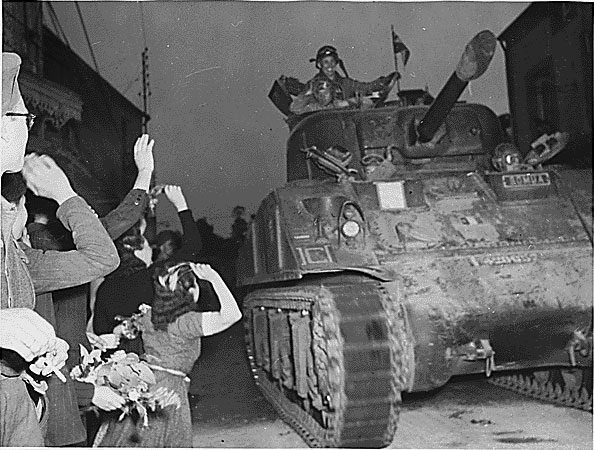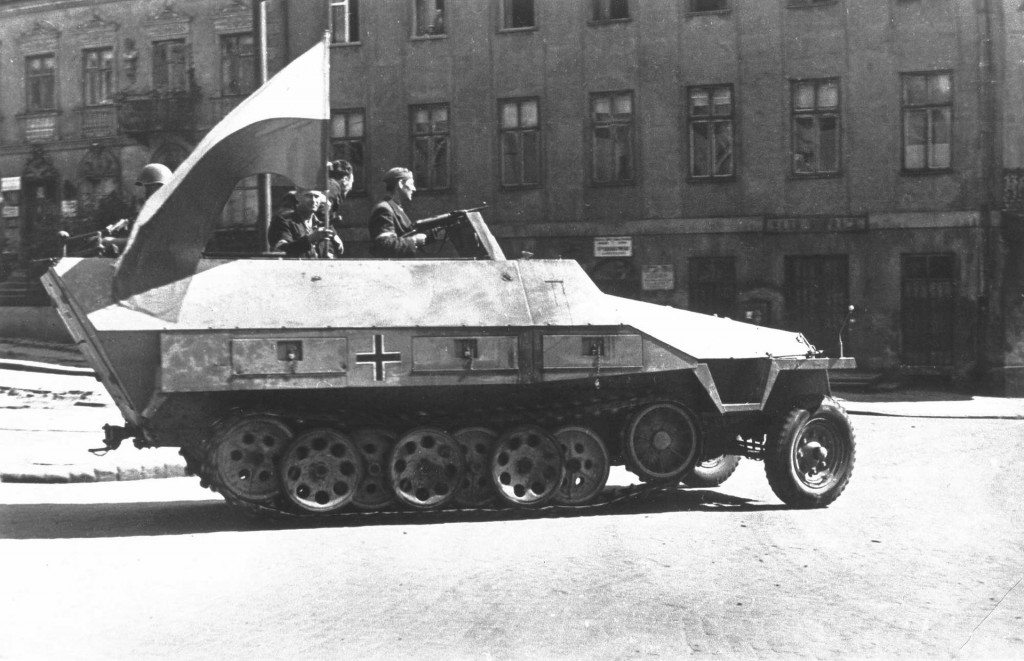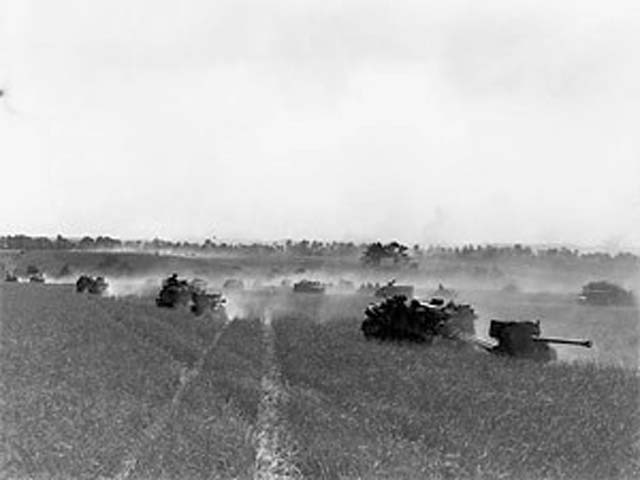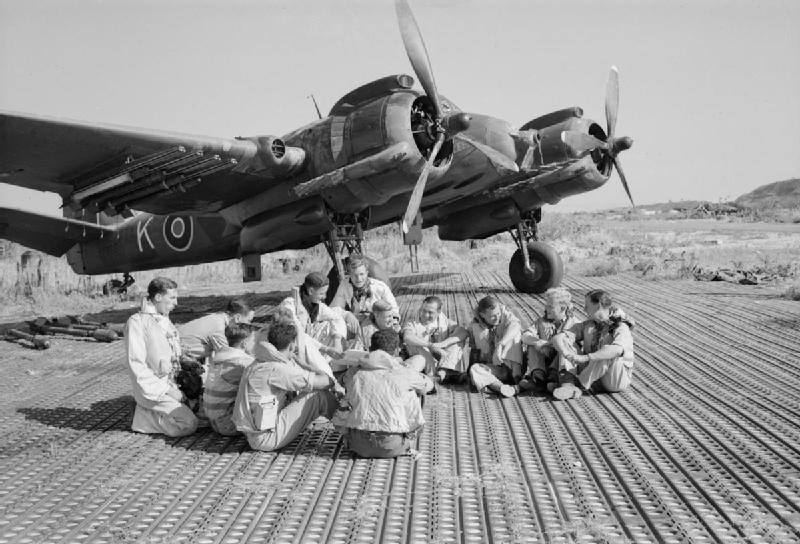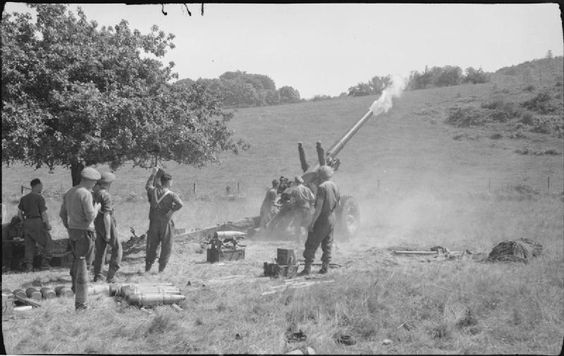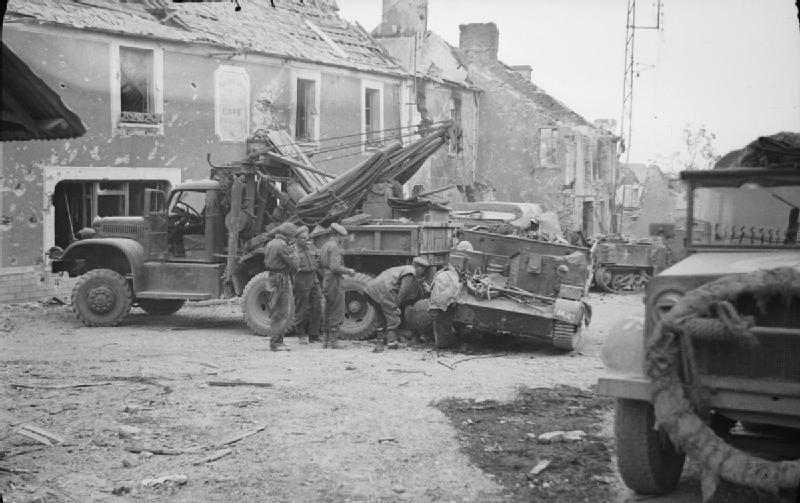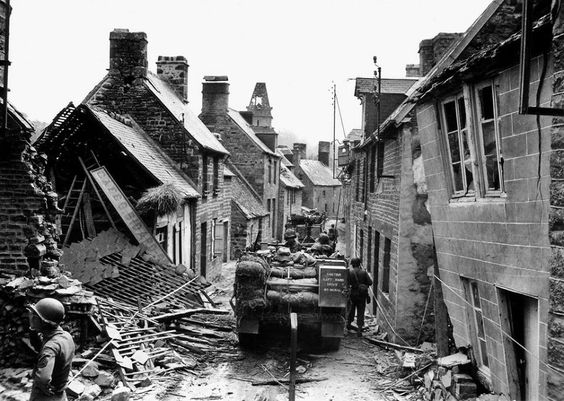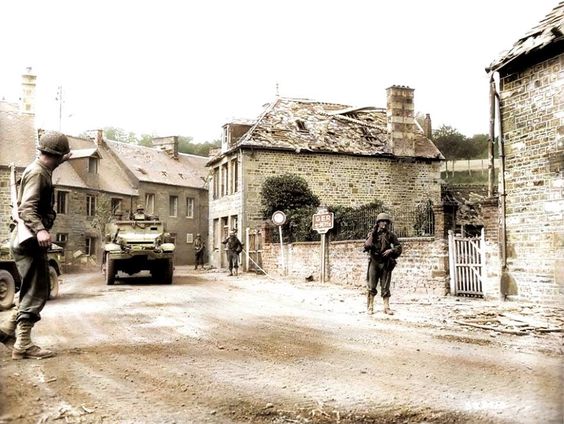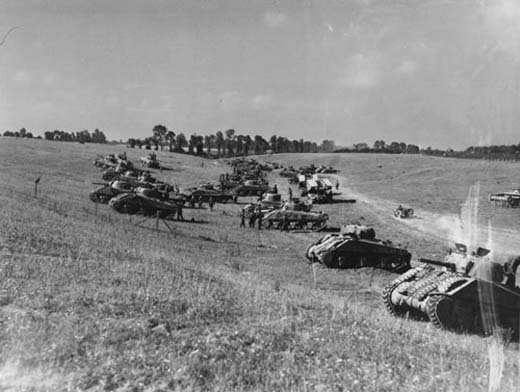Air Operations, Carolines
During the night, 868th Heavy Bomb Squadron SB-24s attack Japanese airfields and defenses in the Palau Islands.
[Air Operations, CBI
BURMA- 10th Air Force B-25s attack Indaw and Mohnyin.
- 18 10th Air Force P-51s attack the Myothit area.
- 46 fighter-bombers attack numerous targets in northern Burma.
- 4 14th Air Force P-40s attack a bridge near Hsenwi.
Air Operations, East Indies
V Bomber Command B-24s and B-25s attack Ternate Island and other targets in the Molucca Islands.
[Air Operations, Europe
RAF aircraft have begun dropping supplies and ammunition for the Polish insurgients in Warsaw.
RAF BOMBER COMMANDDaylight Ops:
- 805 aircraft including 411 Lancasters, 352 Halifaxes and 42 Mosquitos attack 7 German troop positions facing the Canadian 3rd Division which is advancing on Falaise. A careful plan is prepared with Oboe and visual marking, and with a Master Bomber and a deputy at each of the 7 targets. Most of the bombing is accurate and effective but, about half-way through the raids, some aircraft start to bomb a large quarry in which parts of the 12th Canadian Field Regiment are positioned. This mistake may have been caused by the yellow identification flares which are ignited by the Canadians. It is unfortunate that the target indicators being used by the Pathfinders are also yellow. Bomber Command crews claim that the Canadians used the yellow flares before any bombs fell in the quarry. The history of the Canadian units says the bombs fell first. The Master Bombers tries hard to stop further crews bombing in the wrong area, but approximately 70 aircraft bomb the quarry and other nearby Allied positions over a 70-minute period. The Canadians take shelter in their slit trenches and most emerge unscathed though shaken, but 13 men are killed and 53 injured and a large number of vehicles and guns are hit. This is believed to have been the first occasion on which Bomber Command aircraft hits friendly troops during the Battle of Normandy. The Canadian artillery regiment is machine-gunned by RAF Spitfires and USAAF Mustangs the following day.
- 155 Lancasters and 4 Mosquitos of No. 5 Group make 2 separate attacks on ships in Brest harbor. The Clemenceau and the cruiser Gueydon are both hit and are believed sinking in 'safe' positions which will not hinder Allied use of the port when American troops take possession. The Allied forces are anxious to capture a good port to which supplies and reinforcements for the land battle can be brought in directly from the United States.
- 2 Lancasters are lost.
- 1 Wellington flies an RCM sortie.
Details of the Canadian side of the bombing come from Into Action with the 12th Field by Captain TJ Bell (published privately in Canada} and from the personal reminiscences of former Lance-Corporal George R Carter of the 12th Canadian Field Regiment. George Carter's brother, Flying Officer Roy E Carter of No 431 Squadron, was a Bomber Command navigator whose Halifax had been shot down over Holland on the Sterkrade raid of 16/17 June 1944. Roy Carter baled out successfully but, while he was being hidden by Dutch civilians in a house at Tilburg, he was discovered by Germans on 8 July and shot, together with a Pathfinder pilot and an Australian airman. The bloodstained Dutch flag which covered the bodies after their death was brought to England in 1983 and placed in the No 83 Squadron Memorial Chapel in Coningsby parish church.
Minor Ops:
- 32 Mosquitos are sent Berlin, 2 to the Sterkrade oil plant and 2 to the St Trond airfield, 8 Halifaxes and 6 Lancasters lay mines off Biscay ports, 4 aircraft are involved on Resistance operations, and there are 1 RCM and 7 OTU sorties.
- There are no losses.
BELGIUM:
- 33 1st Bomb Division B-17s that are unable to attack assigned targets in Germany divert to attack the Chievres and Florennes/Juzaine Airdromes.
- 72 1st Bomb Division B-17s attack the Metz/Frascati Airdrome.
- A total of 354 2nd Bomb Division B-24s, escorted by 92 VIII Fighter Command fighters, attack three airdromes, two bridges, and a rail junction.
- 76 3rd Bomb Division B-24s, escorted by 40 fighters, attack two rail junctions.
- 136 VIII Fighter Command P-38 and P-47 fighter-bombers attack transportation targets in the Paris area.
- 3 fighter-bombers are lost with their pilots
- 250 1st Bomb Division B-17s and 330 3rd Bomb Division B-17s, escorted by 258 VIII Fighter Command fighters, attack aircraft-engine factories, synthetic-oil factories, and two airdromes at Ludwigshafen, Mannheim, Stuttgart, and several other locations.
- 1 fighter is lost with its pilot
FRANCE:
- IX Bomber Command B-26s and A-20s attack rail bridges and sidings along German Army lines of retreat.
- IX and XIX TAC fighters and fighter-bombers aggressively support rapid advances by Allied ground forces seeking to encircle a large part of the German Army in France.
- 8th and 9th Air Force fighter pilots down 16 Luftwaffe fighters over France between 0700 and 1645 hours.
FRANCE:
- During the day, 144 57th Medium Bomb Wing B-25s and 100 42nd Medium Bomb Wing B-26s demolish nine German Army artillery sites between Toulon and Nice.
- 47th Light Bomb Group A-20s attack three airfields.
- The XII TAC's six P-47 groups, all temporarily based in Corsica, attack radar installations in the Marseille area and a wide variety of tactical positions within the invasion area itself.
- During the night, XII TAC A-20s attack three airdromes in southern France and targets of opportunity in the Rhone River valley.
FRANCE:
- 306 15th Air Force B-17s and B-24s attack 36 German Army gun positions between Genoa, Italy, and Toulon, putting 14 of the batteries out of action.
- 145 15th Air Force P-38s and P-51s strafe radar installations along the invasion coast.
- A total of 205 15th Air Force B-17s and B-24s attack German Army coastal gun positions around Genoa and Savona.
Air Operations, New Guinea
- V Bomber Command B-24s attack the airfield at Babo.
- A-20s, V Fighter Command fighter-bombers, and RAAF aircraft attack Japanese Army ground troops at Kaiten, Terabu, and Wewak.
Air Operations, Volcano Islands
30th Heavy Bomb Group B-24s attack Iwo Jima.
[Battle of the Atlantic
The US LST-921 is damaged by the German submarine U-667 in the English Channel.
[Eastern Front
Red Army troops resume their offensive toward Warsaw.
NORTHERN SECTORThe 3rd Panzer Army begins a relief attack toward Riga from south of Dobele with a force of 180 panzers and assault guns. After bitter fighting the Germans advance 10 miles along the road to Jelgava. The 51st Army is forced to pull back steadily as it is hit from both the west and east.
CENTRAL SECTORThe 47th Army attacks north of Warsaw and the 2nd Tank Army to the south, but are both held by powerful German counterattacks. The IV SS Panzer Corps, newly committed to this sector, inflicts heavy losses upon the Russian armies.
[Mediterranean
The convoys for Operation DRAGOON, after a stopover in Corsica, leave for the south coast of France.
[New Guinea
In the Vogelkop area, a crippled B-24 makes a successful landing on the Middleburg Island airstrip.
[Pacific
- The Japanese transport No. 129 is sunk by the US submarine Cod (SS-224) in the Netherlands East Indies area.
- The US submarine Bluefish (SS-222) sinks the Japanese tanker Shimpo Maru (3135t), previously damaged by the Puffer (SS-268) on August 12, off Golo Island.
- The US submarine Croaker (SS-246) sinks the Japanese gunboat No.7 Daigen Maru (1289t) southwest of Inchon, Korea.
- The US submarine Ray (SS-271) attacks a Japanese convoy off the northwest coast of Borneo and sinks the merchant cargo ship Zuisho Maru (5289t) and damages the cargo ship Uga Maru.
Western Front
The Canadian advance has reached to within about 5 miles of Falaise from the north. RAF heavy bombers drop 3,723 tons of bombs in supporting attacks as the Canadian drive continues.
In Brittany, the resistance of the German garrisons in St Malo and Dinard persists. All of St Malo has been cleared except for the ancient citadel in the port area. The US XV Corps begins to move east from around Argentan toward Dreux. Other units are taking post at Argentan.
The 7th Arm Div and the 5th Div, XX Corps, move in the direction of Chartres, and the XII Corps continues its advance toward Orléans.[WF]
[Images from August 14, 1944
|
|
|
|
|
|
|
|
|
|
|
|
